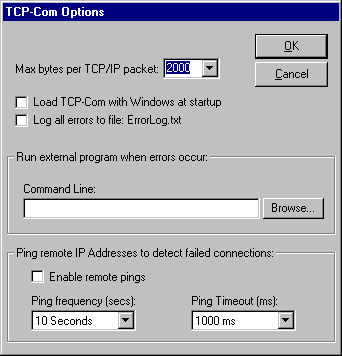|
If you select “Options” in the TCP-Com “File”
menu, the following dialog box will appear:

The “Max bytes per TCP/IP packet” option
allows you to select the maximum number of bytes that TCP-Com
will send out the TCP/IP port in each TCP/IP data packet.
For example, suppose that you are receiving large amounts
of data in the COM port in a continual data stream. This option
allows you to choose the maximum size of any individual TCP/IP
data packet that is sent out the TCP/IP port. If you were
to receive 5000 bytes of data in the COM port and you had
the “Max bytes per TCP/IP packet” option set to
2000, then TCP-Com would break the 5000 bytes of data into
three TCP/IP packets (2 packets of 2000 bytes and one packet
of 1000 bytes) before sending the data out the TCP/IP port.
This option can improve the speed and efficiency of all TCP/IP
data sent out by TCP-Com.
The "Load TCP-Com with Windows at startup"
option causes TCP-Com to automatically run whenever you start
Windows. When TCP-Com launches, it will use the exact same
settings that were in effect the last time that it was run
and it will even automatically activate itself if it was active
when it was last shut down. In addition, TCP-Com will also
automatically minimize itself if it was minimized when it
was last shut down. Basically this option saves you the trouble
of having to put a shortcut to TCP-Com in your Startup folder.
Notes:
1. If you select this option, TCP-Com will only run automatically
when the same workstation user logs onto the PC. If you want
TCP-Com to run automatically at startup for all users of the
workstation, you would need to log onto the PC once for each
user and then run TCP-Com and select this option.
2. If you configure TCP-Com to run as a Windows Service,
do not select the "Load TCP-Com with Windows at startup"
option.
For more information on how to configure TCP-Com to load
as a Windows Service see: Configuring
TCP-Com to run as a Windows Service
The “Log all errors to file ErrorLog.txt”
option causes TCP-Com to create an error log file located
in the same folder with the TCP-Com program files and record
any errors that occur to that file. The purpose of this option
is to provide a means for tracking down any communications
error that may occur including network connection errors.
All errors are recorded with a date and a time stamp as well
as a verbose description of the errors.
You can also configure TCP-Com to run an external program
whenever an error occurs. For example, you could run a program
that sends a notification to someone (perhaps containing a
copy of the ErrorLog.txt file) if the network connection is
disrupted. To configure TCP-Com to run an external program
in the event of an error, enter the command line for the program
that you want to run in the textbox labeled “Command
Line”. If you leave the “Command Line” textbox
empty, TCP-Com will not attempt to run any external program
if it detects an error.
The “Ping remote IP Addresses to detect failed connections”
options allow you to configure TCP-Com to continually ping
the IP address of any remote devices or computers that are
connected to TCP-Com so that it can detect failed network
connections. This option applies both for remotely connected
TCP/IP clients when TCP-Com is configured as a server and
for TCP/IP servers that TCP-Com is connected to as a client.
If you check the checkbox labeled “Enable remote pings”,
TCP-Com will continually ping all connected IP Addresses at
the interval specified in the “Ping Frequency” dropdown
list. The Ping Frequency option determines how often TCP-Com
will issue the pings. If the device or computer at the remotely
connected IP Address does not respond to each ping within
the amount of time specified in the “Ping Timeout”
option, then TCP-Com will consider the connection broken and
it will close the connection and automatically attempt to
re-establish a new connection.
For example, suppose that you are establishing a TCP/IP connection
across an unreliable network (like the Internet) and you want
to insure that your connection remains open no matter what
happens to the network. In many cases, if a network connection
gets lost (perhaps as the result of a network switch or a
router going down or a cable getting disconnected), the client
or the server that has the connection open may not be notified
that the connection has been broken and therefore has no way
to detect that there is a problem. This option basically provides
a reliable means for detecting and automatically repairing
failed network connections. If a network connection is lost,
TCP-Com will continually attempt to re-establish the connection
until it is successful.
See
Also:
Welcome to TCP-Com
Common Applications for TCP-Com
Configuring TCP-Com
TCP/IP Client and Server Options
TCP-Com Advanced Options
Using the Ping Tool
Using the Resolve Host Address
Tool
Saving and Loading TCP-Com configuration
files
Password Protecting TCP-Com
Configuring TCP-Com to run as
a Windows Service
Interfacing RS232 Instruments
to a TCP/IP Network
Using TCP-Com to send/receive
data over the Internet
A Very Basic Overview of
TCP/IP Communications
|
